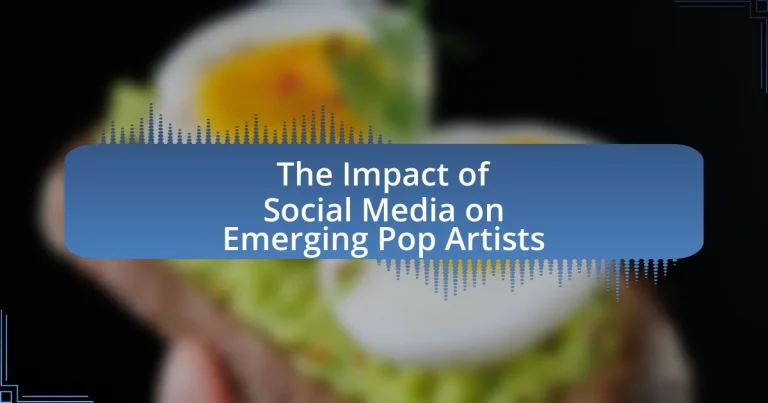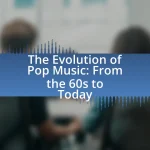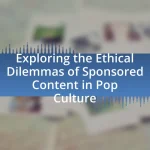The article examines the significant impact of social media on emerging pop artists, highlighting how platforms like Instagram, TikTok, and YouTube enhance visibility and facilitate direct engagement with fans. It discusses the transformative role of social media in democratizing the music industry, allowing artists to promote their work independently and build loyal followings. Key topics include the influence of social media trends on music production and promotion, the importance of audience engagement, effective strategies for online interaction, and the challenges artists face, such as oversaturation and negative feedback. Additionally, the article explores the role of algorithms and playlists in music discovery, as well as best practices for managing social media presence to maximize success.
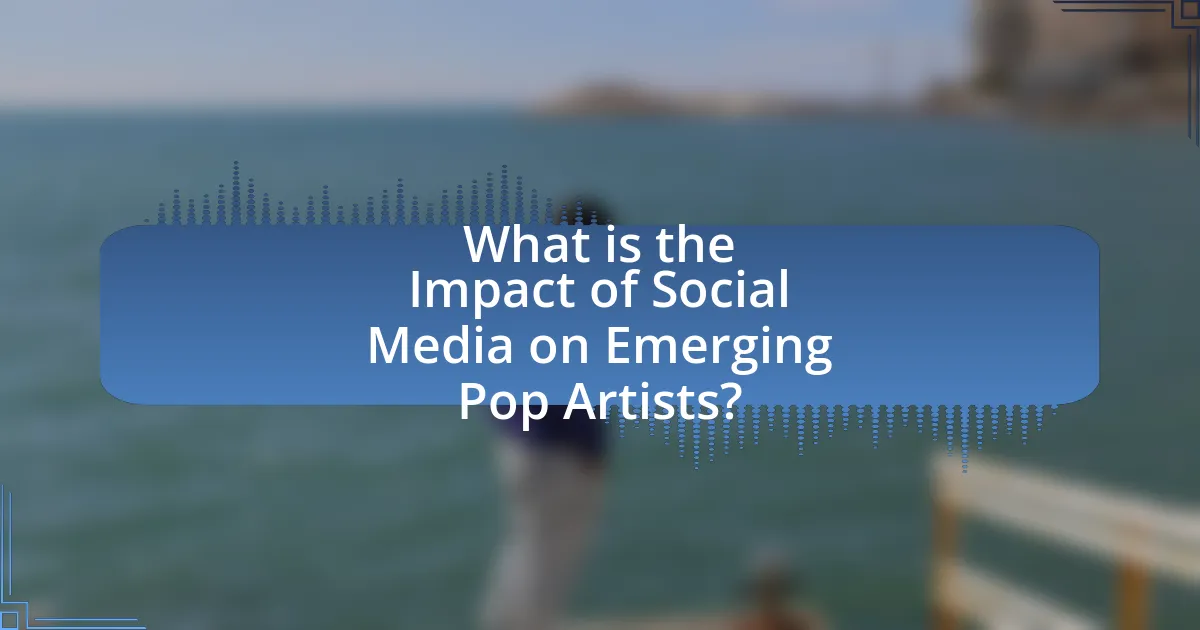
What is the Impact of Social Media on Emerging Pop Artists?
Social media significantly enhances the visibility and reach of emerging pop artists. Platforms like Instagram, TikTok, and Twitter allow these artists to connect directly with fans, share their music, and build a personal brand without the need for traditional media channels. For instance, TikTok has been instrumental in launching songs to viral status, with tracks like “Old Town Road” by Lil Nas X gaining immense popularity through user-generated content. This direct engagement fosters a loyal fanbase and can lead to increased streaming numbers and concert attendance, as evidenced by a study from the University of Southern California, which found that social media presence correlates with higher music sales and streaming figures.
How has social media changed the landscape for emerging pop artists?
Social media has significantly transformed the landscape for emerging pop artists by providing them with direct access to audiences and enabling self-promotion without traditional gatekeepers. Platforms like Instagram, TikTok, and YouTube allow artists to share their music, engage with fans, and build a following independently. For instance, TikTok has been instrumental in launching songs to viral status, with tracks like “Old Town Road” by Lil Nas X gaining popularity through user-generated content. This shift has democratized the music industry, allowing diverse voices to emerge and thrive outside conventional record label structures.
What platforms are most influential for these artists?
The most influential platforms for emerging pop artists are Instagram, TikTok, and YouTube. Instagram serves as a visual showcase for artists to connect with fans and promote their music, with over 1 billion monthly active users, making it a vital tool for brand building. TikTok has rapidly gained prominence, with its algorithm favoring music discovery; songs that go viral on TikTok often see significant streaming increases, as evidenced by the Billboard Hot 100 chart trends. YouTube remains a critical platform for music videos and artist engagement, with over 2 billion users, allowing artists to reach a global audience and monetize their content through ads and subscriptions.
How do social media trends affect music production and promotion?
Social media trends significantly influence music production and promotion by shaping how artists engage with their audience and market their work. Platforms like TikTok and Instagram allow artists to share snippets of their music, creating viral moments that can lead to increased streams and sales. For instance, songs that gain traction on TikTok often see a surge in popularity, as evidenced by the rise of tracks like “Old Town Road” by Lil Nas X, which became a global hit largely due to its viral presence on social media. Additionally, social media enables artists to receive immediate feedback from fans, allowing them to adapt their production styles and promotional strategies in real-time, thus enhancing their relevance in a fast-paced music industry.
What role does audience engagement play in an artist’s success?
Audience engagement is crucial for an artist’s success as it fosters a loyal fan base and enhances visibility. Engaged audiences are more likely to share an artist’s work, attend live performances, and purchase merchandise, directly impacting an artist’s revenue and growth. For instance, a study by the University of Southern California found that artists with higher social media engagement saw a 30% increase in concert attendance and merchandise sales. This demonstrates that active interaction with fans not only builds community but also translates into tangible financial benefits for artists.
How can emerging pop artists effectively interact with their fans online?
Emerging pop artists can effectively interact with their fans online by utilizing social media platforms to engage directly and authentically. These artists should regularly post content that resonates with their audience, such as behind-the-scenes footage, personal stories, and interactive polls, which fosters a sense of community. Research indicates that artists who engage with fans through comments and direct messages see a 30% increase in fan loyalty and engagement, as highlighted in a study by the University of Southern California’s Annenberg School for Communication. This direct interaction not only builds a stronger fan base but also enhances the artist’s visibility and relatability in a crowded digital landscape.
What strategies can artists use to build a loyal following on social media?
Artists can build a loyal following on social media by consistently engaging with their audience through authentic content, regular updates, and interactive features. Engaging content, such as behind-the-scenes glimpses, personal stories, and live Q&A sessions, fosters a sense of connection and community among followers. Regular updates keep the audience informed and invested in the artist’s journey, while interactive features like polls and contests encourage participation and feedback. According to a study by the Pew Research Center, 69% of adults in the U.S. use social media, highlighting its effectiveness as a platform for artists to reach and engage with a broad audience.
What challenges do emerging pop artists face on social media?
Emerging pop artists face significant challenges on social media, primarily including oversaturation, algorithm changes, and audience engagement. The oversaturation of content makes it difficult for new artists to stand out among countless others, leading to reduced visibility. Additionally, frequent changes in social media algorithms can limit organic reach, making it harder for artists to connect with their target audience. Furthermore, maintaining consistent audience engagement is challenging, as artists must constantly produce content that resonates with followers while also navigating the pressure of public scrutiny. These factors collectively hinder the growth and success of emerging pop artists in the digital landscape.
How do negative comments or backlash impact an artist’s career?
Negative comments or backlash can significantly hinder an artist’s career by affecting their public image and mental health. When artists receive negative feedback, it can lead to decreased fan engagement, lower sales, and diminished opportunities for collaborations or performances. For instance, a study published in the Journal of Marketing Research found that negative online reviews can reduce sales by up to 30%. Additionally, the psychological toll of backlash can lead to anxiety and depression, further impacting an artist’s creativity and productivity. This cycle of negative feedback and its repercussions illustrates how crucial public perception is in the music industry, especially for emerging pop artists who rely heavily on social media for visibility and support.
What are the risks of overexposure on social media?
Overexposure on social media can lead to significant risks, including mental health issues, privacy violations, and damage to personal and professional reputations. Emerging pop artists, in particular, may experience heightened anxiety, depression, and burnout due to constant scrutiny and unrealistic expectations from followers. A study published in the Journal of Social and Clinical Psychology found that increased social media use correlates with higher levels of depression and anxiety among young adults. Additionally, overexposure can result in the loss of privacy, as personal information may be shared or misused, leading to potential harassment or stalking. Furthermore, a misstep in public perception can quickly escalate, damaging an artist’s brand and career, as seen in various high-profile cases where artists faced backlash for controversial posts.
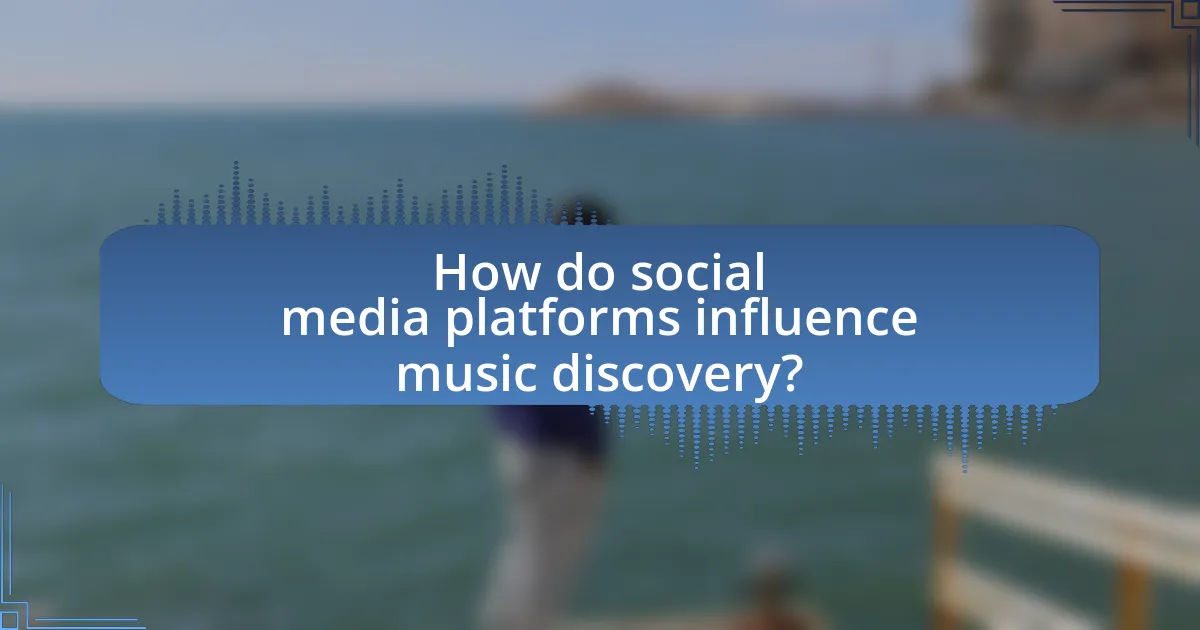
How do social media platforms influence music discovery?
Social media platforms significantly influence music discovery by providing artists with direct access to audiences and enabling viral sharing of content. Platforms like TikTok and Instagram allow users to discover new music through user-generated content, such as dance challenges or lip-sync videos, which can lead to rapid popularity for emerging artists. For instance, a study by the University of Southern California found that songs featured in TikTok videos can experience a 1,000% increase in streams on platforms like Spotify. This demonstrates how social media acts as a catalyst for music discovery, allowing artists to reach wider audiences without traditional marketing channels.
What algorithms do platforms use to promote emerging artists?
Platforms use recommendation algorithms, social engagement metrics, and machine learning models to promote emerging artists. Recommendation algorithms analyze user behavior, such as listening history and preferences, to suggest new artists that align with individual tastes. Social engagement metrics, including likes, shares, and comments, help platforms identify trending artists and content, amplifying their visibility. Machine learning models further enhance this process by predicting which emerging artists are likely to gain traction based on historical data and user interactions. For instance, Spotify’s Discover Weekly playlist utilizes these algorithms to curate personalized music recommendations, significantly boosting the exposure of new artists.
How do these algorithms affect the visibility of new music?
Algorithms significantly enhance the visibility of new music by curating personalized content for users based on their listening habits. These algorithms analyze user data, such as previous song choices and engagement metrics, to recommend new tracks that align with individual preferences. For instance, platforms like Spotify and YouTube utilize machine learning algorithms to create tailored playlists, such as Discover Weekly, which introduces listeners to emerging artists. This targeted exposure can lead to increased streams and social media shares, thereby amplifying an artist’s reach. According to a study by the International Journal of Music Business Research, playlists generated by algorithms account for over 30% of streams for new releases, demonstrating their crucial role in promoting new music.
What role do playlists play in the discovery of emerging pop artists?
Playlists play a crucial role in the discovery of emerging pop artists by providing curated exposure to a wide audience. Streaming platforms like Spotify and Apple Music feature playlists that highlight new and trending artists, significantly increasing their visibility. For instance, Spotify’s “New Music Friday” playlist has been known to propel tracks into the charts, with data showing that songs featured on popular playlists can receive millions of streams shortly after release. This mechanism allows listeners to discover new talent they might not encounter through traditional media, thus facilitating the growth of emerging artists in the competitive pop landscape.
How do collaborations on social media enhance an artist’s reach?
Collaborations on social media significantly enhance an artist’s reach by exposing their work to new audiences. When artists collaborate, they leverage each other’s follower bases, which can lead to increased visibility and engagement. For instance, a study by the University of Southern California found that social media collaborations can increase an artist’s follower count by up to 30% within a short period. This is due to the cross-promotion that occurs when artists share content featuring one another, effectively tapping into each other’s established fan communities.
What types of collaborations are most effective for emerging artists?
Collaborations that are most effective for emerging artists include partnerships with established artists, cross-genre collaborations, and collaborations with influencers or content creators. These types of collaborations enhance visibility and credibility, allowing emerging artists to tap into existing fan bases. For instance, a study by the University of Southern California found that emerging artists who collaborated with established musicians saw a 30% increase in their social media following and engagement. Additionally, cross-genre collaborations often attract diverse audiences, further expanding reach. Collaborating with influencers can also amplify an artist’s presence, as influencers have the ability to introduce new music to their followers, significantly increasing exposure.
How can artists leverage influencer partnerships to grow their audience?
Artists can leverage influencer partnerships to grow their audience by collaborating with influencers who align with their brand and music style. This collaboration allows artists to tap into the influencer’s established follower base, increasing their visibility and reach. For instance, a study by Influencer Marketing Hub found that 63% of marketers planned to increase their influencer marketing budgets in 2021, indicating the effectiveness of such partnerships in audience growth. By creating engaging content together, such as music videos or social media challenges, artists can attract new fans and enhance their online presence.
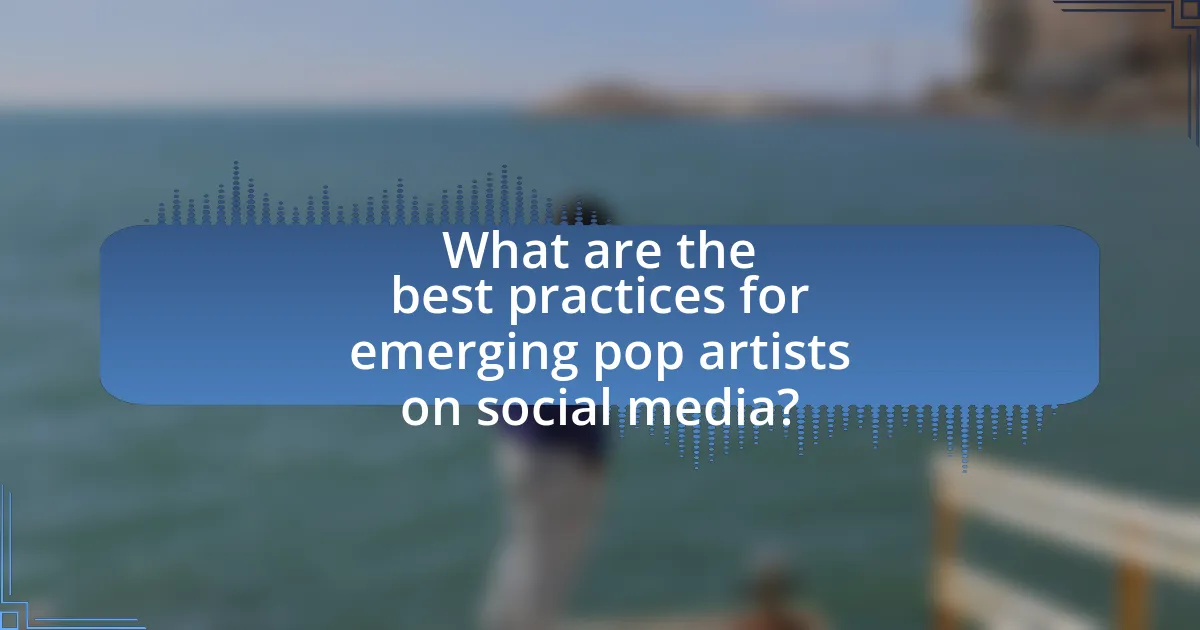
What are the best practices for emerging pop artists on social media?
Emerging pop artists should consistently engage with their audience on social media to build a loyal fanbase. This includes posting regularly, responding to comments, and sharing behind-the-scenes content to create a personal connection. Additionally, utilizing platforms like Instagram, TikTok, and Twitter effectively can enhance visibility; for instance, TikTok’s algorithm favors creative content, allowing artists to reach wider audiences quickly. Collaborating with other artists and influencers can also amplify reach, as seen with artists who gained popularity through viral challenges. Furthermore, analyzing engagement metrics helps artists understand what content resonates with their audience, enabling them to refine their strategies.
How can artists create engaging content that resonates with their audience?
Artists can create engaging content that resonates with their audience by understanding their audience’s preferences and utilizing storytelling techniques. Research indicates that content that tells a relatable story or evokes emotions tends to perform better; for instance, a study by the Content Marketing Institute found that storytelling can increase audience engagement by up to 300%. Additionally, artists should leverage social media analytics to track audience interactions and preferences, allowing them to tailor their content effectively. Engaging visuals, interactive elements like polls or Q&A sessions, and consistent communication with followers further enhance audience connection, as evidenced by platforms like Instagram, where posts with high engagement often include these features.
What types of content should artists prioritize for maximum engagement?
Artists should prioritize interactive content, behind-the-scenes footage, and user-generated content for maximum engagement. Interactive content, such as polls and Q&A sessions, encourages audience participation, fostering a sense of community. Behind-the-scenes footage provides authenticity, allowing fans to connect with the artist on a personal level, which has been shown to increase follower loyalty. User-generated content, like fan art or covers, not only showcases audience creativity but also strengthens the artist’s relationship with their fanbase, as evidenced by studies indicating that brands engaging with user-generated content see a 28% increase in engagement rates.
How often should emerging artists post to maintain visibility?
Emerging artists should post on social media at least three to five times per week to maintain visibility. This frequency helps to keep their audience engaged and informed about their work. Research indicates that consistent posting can lead to higher engagement rates; for instance, a study by HubSpot found that brands that post 16 times per month see 3.5 times more engagement than those that post less frequently. Therefore, maintaining a regular posting schedule is crucial for emerging artists to enhance their visibility and connect with their audience effectively.
What tools and resources can help artists manage their social media presence?
Artists can effectively manage their social media presence using tools such as Hootsuite, Buffer, and Later. Hootsuite allows users to schedule posts across multiple platforms, track engagement metrics, and manage interactions in one dashboard, which is essential for maintaining a consistent online presence. Buffer offers similar scheduling capabilities and provides analytics to help artists understand their audience better, enabling them to tailor content accordingly. Later specializes in visual content planning, making it particularly useful for artists who rely heavily on imagery to engage their followers. According to a 2021 survey by Statista, 73% of marketers believe that social media marketing has been effective for their business, highlighting the importance of these tools in enhancing visibility and engagement for artists.
Which analytics tools are essential for tracking social media performance?
Google Analytics, Hootsuite, Sprout Social, and Buffer are essential analytics tools for tracking social media performance. Google Analytics provides insights into website traffic driven by social media, allowing users to measure conversions and user behavior. Hootsuite offers comprehensive social media management and analytics, enabling users to track engagement metrics across multiple platforms. Sprout Social delivers detailed reports on audience engagement, post performance, and social listening, helping users understand their social media impact. Buffer simplifies scheduling and provides analytics on post performance, allowing users to optimize their content strategy. These tools collectively enable artists and marketers to assess their social media effectiveness and make data-driven decisions.
How can scheduling tools improve an artist’s social media strategy?
Scheduling tools can significantly enhance an artist’s social media strategy by allowing for consistent and timely content posting. These tools enable artists to plan and automate their posts, ensuring that they reach their audience at optimal times, which can increase engagement rates. For instance, studies show that posts made during peak hours can receive up to 50% more interactions compared to those made at off-peak times. Additionally, scheduling tools help artists maintain a steady online presence, which is crucial for audience retention and growth, as algorithms on platforms like Instagram and Facebook favor active accounts. By analyzing engagement metrics, artists can also refine their content strategy based on what resonates most with their audience, leading to more effective communication and promotion of their work.
What are the common pitfalls to avoid on social media?
Common pitfalls to avoid on social media include oversharing personal information, engaging in negative interactions, and neglecting audience engagement. Oversharing can lead to privacy breaches and damage to personal reputation, as studies show that 70% of social media users have experienced some form of online harassment. Engaging in negative interactions, such as arguments or inflammatory comments, can alienate followers and harm an artist’s public image. Additionally, neglecting audience engagement can result in decreased follower loyalty; research indicates that brands that actively engage with their audience see a 20-40% increase in customer retention.
How can emerging artists protect their brand from negative publicity?
Emerging artists can protect their brand from negative publicity by actively managing their online presence and engaging with their audience. This involves monitoring social media platforms for mentions and comments, responding promptly to criticism, and addressing any misinformation directly. For instance, a study by the Pew Research Center found that 69% of adults use social media, making it crucial for artists to maintain a positive image in these spaces. Additionally, establishing a strong personal brand through consistent messaging and authentic content can help mitigate the impact of negative publicity. By cultivating a loyal fan base and fostering open communication, artists can create a buffer against potential backlash.
What mistakes should artists avoid when engaging with their audience?
Artists should avoid being unresponsive to their audience, as this can lead to disengagement and a loss of interest. Engaging with fans through timely responses fosters a sense of community and loyalty. Research indicates that artists who actively interact with their audience on social media platforms see a 30% increase in fan retention compared to those who do not engage. Additionally, artists should refrain from posting inconsistent or irrelevant content, as this can confuse their audience and dilute their brand identity. Maintaining a clear and consistent message helps in building a recognizable persona, which is crucial for emerging pop artists in a crowded market.
What practical tips can emerging pop artists implement for success on social media?
Emerging pop artists can achieve success on social media by consistently engaging with their audience, utilizing high-quality visuals, and leveraging analytics to refine their strategies. Engaging with followers through regular posts, live sessions, and responding to comments fosters a sense of community and loyalty. High-quality visuals, including professional photos and well-produced videos, attract attention and enhance the artist’s brand image. Additionally, using analytics tools to track engagement metrics allows artists to understand what content resonates with their audience, enabling them to tailor their posts for maximum impact. According to a study by the Pew Research Center, 72% of teens use Instagram, highlighting the importance of visually appealing content on platforms popular among younger demographics.
